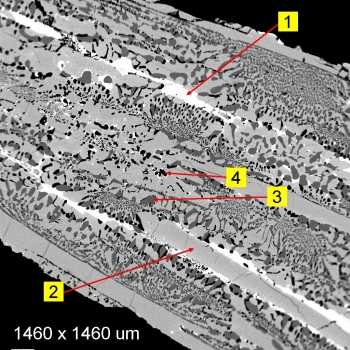This sample in the image at the left was suspected of being a metallic meteorite, for which the metallic phase characteristically should be an Fe-Ni alloy. This backscattered electron image shows morphologies consistent with quenching (very rapid cooling) of molten material rather than the repetitive exsolution textures (Widmanstätten patterns) that are characteristic of (hexahedral) Ni-Fe meteorites. Qualitative analysis by EDXA shows the individual components to be: (1) Pb-Cu-Sballoys; (2) Fe-As alloy; (3) Fe metal; and (4) Fe-sulfide. Hence, the textures and compositions of the component phases identify this material as more likely being a metallurgical slag than a metallic Ni-Fe meteorite.
Qualitative Analysis
In simplest terms, qualitative analysis involves the determination of what elements are present in the portion of the sample irradiated by the electron beam. This is accomplished by resolving and identifying the (elements giving rise to) fluorescent characteristic x-rays emitted from the sample. Qualitative analysis has three principal applications: phase identification, identification of elements present for quantitative analysis, and determining proper background offsets for quantitative analysis by WDS. Phase identification is by far the dominant use of qualitative methods, and is an especially valuable tool for characterizing complex, fine-grained materials. This is demonstrated in the following example.

Methods and Analysis Time
As in quantitative analysis, there are two techniques for the qualitative resolution of fluorescent x-rays: Energy-Dispersive X-ray Analysis (EDXA) and Wavelength-Dispersive Spectrometry (WDS) (for more information on these methods, see the "Analyzer" section of What is an electron microprobe?).
EDXA is the more commonly used method for simple phase identification, because it is extremely rapid: an entire x-ray spectrum of an unknown can be acquired and displayed in a matter of seconds. Because the relative intensities of x-ray lines displayed in the spectrum are proportional to the abundances of elements in the sample (especially for x-rays arising from similar types of electron transitions), EDXA spectra allow users to estimate the chemical stoichiometry of the sampled compound. This application can be enhanced by semi-quantitative approaches involving rapid standardless analytical methods, which take only a few additional seconds and can provide a reasonable estimate of elemental weight fractions, oxide weight fractions, or atomic proportions. EDXA is especially useful on rough samples, because the detection of x-rays is not as dependent on beam-sample-detector geometry as is the WDS method. Therefore, EDXA can be used very effectively with electron imaging methods to characterize loose grains or unpolished materials. The principal limitation of EDXA as a qualitative tool lies in detecting elements present at trace levels, which produce weak intensities that are commonly very difficult to resolve from the background x-radiation (the "Bremmstrählung", which is white x-radiation produced by the deceleration of electrons of the primary beam).
Qualitative analysis by WDS involves scanning one or more spectrometers along a specified geometric interval, to record the intensities of all x-ray wavelengths reaching the detector. By specifying the range of spectrometer movement(s) and the diffraction element(s) (with particular interplanar spacing), the analyst can accumulate either a complete record of the x-ray spectrum or concentrate on wavelength regions for specified elements. Although a bit more time consuming than EDXA, rapid scans of the spectrometers can acquire a complete x-ray spectrum in about 1 minute. The principal advantages of qualitative analysis by WDS are superior resolution of x-ray lines and higher peak/background intensity ratios compared to EDXA. In conjunction with options for extended counting times and controlling the wavelength regions scanned, these advantages are particularly important in identifying the presence of elements at trace to minor level abundance.

